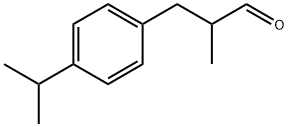cyclamen aldehyde
Synonym(s):Cyclamen aldehyde
- CAS NO.:103-95-7
- Empirical Formula: C13H18O
- Molecular Weight: 190.28
- MDL number: MFCD00024160
- EINECS: 203-161-7
- SAFETY DATA SHEET (SDS)
- Update Date: 2024-12-18 14:15:30

What is cyclamen aldehyde?
Description
2-Methyl-3-(p-isopropylphenyl) propionaldehyde has a strong, flowery odor. May be prepared by condensation of cuminic aldehyde and propionaldehyde followed by hydrogenation in the presence of a catalyst.
Chemical properties
The commercially available racemate is a colorless to yellowish liquid with an intense floral odor reminiscent of Cyclamen europaeum (cyclamen, sowbread).
Production. Two main processes are used for the industrial synthesis of cyclamen aldehyde:
1) Alkaline condensation of 4-isopropylbenzaldehyde and propanal results, via the aldol, in the formation of 2-methyl-3-(4-isopropylphenyl)-2-propenal. The unsaturated aldehyde is hydrogenated selectively to the saturated aldehyde in the presence of potassium acetate and a suitable catalyst, such as palladium–alumina:
2) Friedel–Crafts reaction of isopropylbenzene and 2-methylpropenal diacetate (methacrolein diacetate) in the presence of titanium tetrachloride/boron trifluoride etherate gives cyclamen aldehyde enolacetate, which is hydrolyzed to aldehyde:
Uses. Cyclamen aldehyde is an important component for obtaining special blossomnotes in perfume compositions, particularly the cyclamen type. Because of its fresh, floral aspect, it is also used as the top note in many other blossomfragrances.
Chemical properties
2-Methyl-3-(p-isopropylphenyl)-propionaldehyde has a strong, flowery odor
Occurrence
Reported found in nutmeg and starfruit.
The Uses of cyclamen aldehyde
Cyclamen Aldehyde is a very powerful, floral, green note used in many perfumery applications to blend into fresh, floral, green or ozonic/marine accords. It is an ingredient with growing use and importance in helping to build replacement accords for materials disappearing from the Perfumers’ palette. Cyclamen has good overall stability except in extremes of pH. It has good tenacity and substantivity and represents very good value for money in new creations.
The Uses of cyclamen aldehyde
Cyclamal, is an ingredient in perfume. It can also be used in the synthesis of Cyclamen Alcohol (C987655).
Preparation
By condensation of cuminic aldehyde and propionaldehyde followed by hydrogenation in the presence of a catalyst
Definition
ChEBI: Xi-3-(4-Isopropylphenyl)-2-methylpropanal is a monoterpenoid.
Safety Profile
Moderately toxic by ingestion. A human skin irritant. See also ALDEHYDES. When heated to decomposition it emits acrid smoke and irritating fumes.
Synthesis
Cyclamen aldehyde is synthesized from Cuminaldehyde plus Ropionaldehyde by condensation followed by selective hydrogenation and finally dehydrogenation of the Cyclamen alcohol to aldehyde.
Properties of cyclamen aldehyde
| Boiling point: | 270 °C(lit.) |
| Density | 0.95 g/mL at 25 °C(lit.) |
| vapor pressure | 0.3Pa at 20℃ |
| refractive index | n |
| FEMA | 2743 | 2-METHYL-3-(P-ISOPROPYLPHENYL)PROPIONALDEHYDE |
| Flash point: | 228 °F |
| storage temp. | Inert atmosphere,Room Temperature |
| solubility | Chloroform (Slightly), Ethyl Acetate, Methanol (Slightly) |
| form | Oil |
| color | Colourless liquid. |
| Odor | Powerful floral-green with a characteristic cucumber-melon note used in floral types. |
| Water Solubility | 66mg/L at 20℃ |
| JECFA Number | 1465 |
| Stability: | Hygroscopic |
| CAS DataBase Reference | 103-95-7(CAS DataBase Reference) |
| EPA Substance Registry System | Benzenepropanal, .alpha.-methyl-4-(1-methylethyl)- (103-95-7) |
Safety information for cyclamen aldehyde
| Signal word | Warning |
| Pictogram(s) |
 Exclamation Mark Irritant GHS07 |
| GHS Hazard Statements |
H315:Skin corrosion/irritation H317:Sensitisation, Skin H412:Hazardous to the aquatic environment, long-term hazard |
| Precautionary Statement Codes |
P261:Avoid breathing dust/fume/gas/mist/vapours/spray. P264:Wash hands thoroughly after handling. P264:Wash skin thouroughly after handling. P272:Contaminated work clothing should not be allowed out of the workplace. P273:Avoid release to the environment. P280:Wear protective gloves/protective clothing/eye protection/face protection. P302+P352:IF ON SKIN: wash with plenty of soap and water. |
Computed Descriptors for cyclamen aldehyde
cyclamen aldehyde manufacturer
Privi Speciality Chemicals Ltd.
New Products
(S)-3-Aminobutanenitrile hydrochloride 4-Methylphenylacetic acid N-Boc-D-alaninol N-BOC-D/L-ALANINOL Tert-butyl bis(2-chloroethyl)carbamate 3-Morpholino-1-(4-nitrophenyl)-5,6-dihydropyridin- 2(1H)-one Furan-2,5-Dicarboxylic Acid Tropic acid 1-Bromo-3,5-Di-Tert-Butylbenzene S-2-CHLORO PROPIONIC ACID ETHYL ISOCYANOACETATE 2-Bromo-1,3-Bis(Dimethylamino)Trimethinium Hexafluorophosphate 4-IODO BENZOIC ACID 3-NITRO-2-METHYL ANILINE 1-(2,4-DICHLOROPHENYL) ETHANAMINE (2-Hydroxyphenyl)acetonitrile 4-Bromopyrazole 2-(Cyanocyclohexyl)acetic acid 4-methoxy-3,5-dinitropyridine 1-(4-(aminomethyl)benzyl)urea hydrochloride 2-aminopropyl benzoate hydrochloride diethyl 2-(2-((tertbutoxycarbonyl)amino) ethyl)malonate tert-butyl 4- (ureidomethyl)benzylcarbamate Ethyl-2-chloro((4-methoxyphenyl)hydrazono)acetateRelated products of tetrahydrofuran

![1-[6-HYDROXY-4-(4-ISOPROPYLPHENYL)-3,6-DIMETHYL-4,5,6,7-TETRAHYDRO-2,1-BENZISOXAZOL-5-YL]ETHANONE](https://img.chemicalbook.in/StructureFile/ChemBookStructure6/GIF/CB2762766.gif)



![1-[6-HYDROXY-4-(4-ISOPROPYLPHENYL)-3,6-DIMETHYL-4,5,6,7-TETRAHYDRO-2H-INDAZOL-5-YL]ETHANONE](https://img.chemicalbook.in/StructureFile/ChemBookStructure8/GIF/CB9299016.gif)

![ETHYL 2-(2-(4-TERT-BUTYLPHENYL)CYCLOPROPANECARBOXAMIDO)-4,5,6,7-TETRAHYDROBENZO[B]THIOPHENE-3-CARBOXYLATE](https://img.chemicalbook.in/StructureFile/ChemBookStructure4/GIF/CB4774994.gif)
You may like
-
 103-95-7 / 6658-48-6 Cyclamen Aldehyde 98%View Details
103-95-7 / 6658-48-6 Cyclamen Aldehyde 98%View Details
103-95-7 / 6658-48-6 -
 103-95-7 / 6658-48-6 99%View Details
103-95-7 / 6658-48-6 99%View Details
103-95-7 / 6658-48-6 -
 3-(4-Isopropylphenyl)isobutyraldehyde CAS 103-95-7View Details
3-(4-Isopropylphenyl)isobutyraldehyde CAS 103-95-7View Details
103-95-7 -
 3-(4-ISOPROPYLPHENYL)-2-METHYLPROPIONALDEHYDE CAS 103-95-7View Details
3-(4-ISOPROPYLPHENYL)-2-METHYLPROPIONALDEHYDE CAS 103-95-7View Details
103-95-7 -
 1975-50-4 98%View Details
1975-50-4 98%View Details
1975-50-4 -
 2-HYDROXY BENZYL ALCOHOL 98%View Details
2-HYDROXY BENZYL ALCOHOL 98%View Details
90-01-7 -
 14714-50-2 (2-Hydroxyphenyl)acetonitrile 98+View Details
14714-50-2 (2-Hydroxyphenyl)acetonitrile 98+View Details
14714-50-2 -
 118753-70-1 98+View Details
118753-70-1 98+View Details
118753-70-1